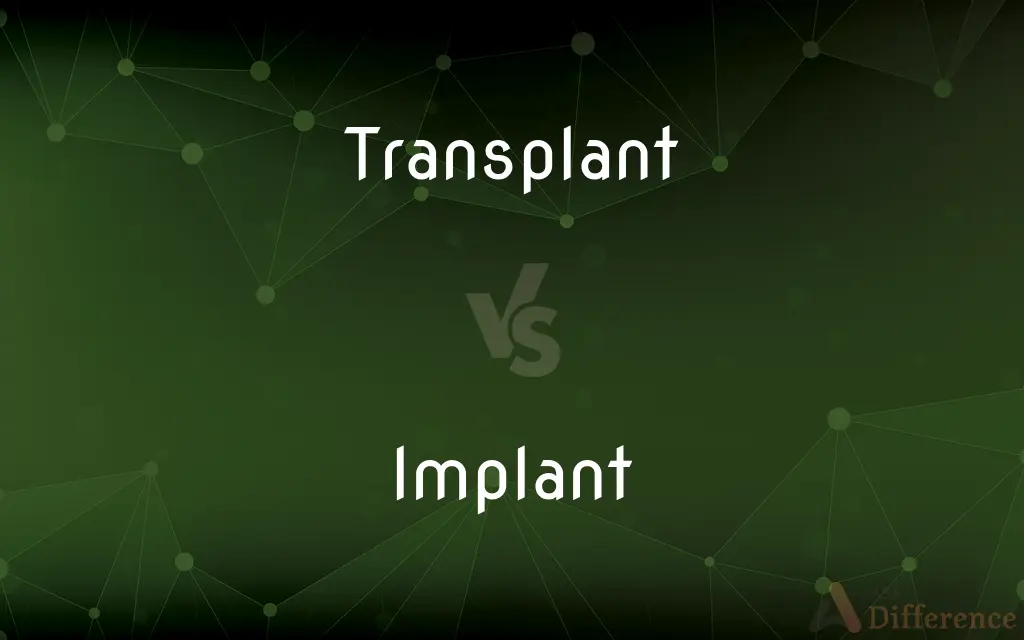Transplant vs. Implant — What's the Difference?
By Fiza Rafique & Urooj Arif — Updated on March 24, 2024
Transplants involve moving organs, tissues, or cells from one body to another or within the same body to replace damaged ones. Implants are artificial devices inserted into the body to replace, support, or enhance biological functions.

Difference Between Transplant and Implant
Table of Contents
ADVERTISEMENT
Key Differences
Transplants are medical procedures involving the replacement of malfunctioning or damaged organs, tissues, or cells within one's own body (autograft) or from a donor (allograft) to restore normal function. These can include heart, kidney, or bone marrow transplants. Whereas implants refer to the insertion of artificial objects, such as pacemakers, hip replacements, or cosmetic prosthetics, into the body to repair, enhance, or substitute for body parts, often made from materials like metal, silicone, or plastic.
While transplants primarily address the failure of biological systems and aim to mimic or restore their original function using living materials, implants often introduce non-biological elements to the body to improve or replace biological functions. On the other hand, both procedures aim to improve the quality of life but through fundamentally different approaches: biological replacement vs. technological augmentation.
Transplantation procedures are often complex and require considerations of immunological compatibility to prevent rejection by the recipient's immune system, necessitating the use of immunosuppressive drugs. In contrast, implants focus on biocompatibility and mechanical reliability, with risks associated with surgical implantation and the long-term presence of foreign materials in the body.
The success of transplants significantly depends on the availability of suitable donors and the body's acceptance of the transplanted organ or tissue. Implants, however, are limited by technological advancements and the body's ability to integrate with artificial materials, posing challenges such as infection risk and device failure.
Comparison Chart
Definition
Moving biological materials to replace damaged ones
Inserting artificial devices to enhance functions
ADVERTISEMENT
Primary Focus
Biological systems and functions
Technological augmentation
Materials Used
Organs, tissues, cells
Metals, silicone, plastics
Main Considerations
Immunological compatibility, donor availability
Biocompatibility, mechanical reliability
Purpose
Restore normal biological function
Repair, enhance, or substitute biological functions
Compare with Definitions
Transplant
Aimed at replacing malfunctioning biological parts.
The cornea transplant restored her vision.
Implant
Used for a wide range of medical conditions.
The cochlear implant allowed him to hear again.
Transplant
Requires matching and compatibility tests.
The bone marrow transplant required a perfect match.
Implant
Made from various materials like titanium or silicone.
The hip replacement used a titanium implant.
Transplant
The transfer of organs, tissues, or cells from one location to another.
The heart transplant saved the patient's life.
Implant
Designed to last many years but may require replacement.
The pacemaker implant will need to be replaced in ten years.
Transplant
Can occur within the same body, known as an autograft.
The skin graft for the burn was an autograft.
Implant
An artificial device inserted into the body.
The dental implant replaced the missing tooth.
Transplant
Involves living donors or deceased donors.
He received a kidney transplant from a living donor.
Implant
Can be cosmetic, such as chest implants.
She considered getting chest implants for cosmetic reasons.
Transplant
To uproot and replant (a growing plant).
Implant
To set in firmly, as into the ground
Implant fence posts.
Transplant
To transfer from one place or residence to another; resettle or relocate
Residents were transplanted to the suburbs during the massive reconstruction project.
Implant
To establish securely, as in the mind or consciousness; instill
Habits that had been implanted early in childhood.
Transplant
(Medicine) To transfer (tissue, a body structure, or an organ) from one body to another body or from one part of a body to another part.
Implant
To insert or embed (an object or a device) surgically
Implant a drug capsule.
Implant a pacemaker.
Transplant
To be capable of being transplanted
Plants that transplant well.
Implant
To graft or insert (a tissue) within the body.
Transplant
The act or process of transplanting something.
Implant
To become attached to and embedded in the uterine lining. Used of a fertilized egg.
Transplant
(Medicine) An operation in which an organ, body part, or other tissue is transplanted
A corneal transplant.
Implant
Something implanted, especially a surgically implanted tissue or device
A dental implant.
A subcutaneous implant.
Transplant
A plant that has been uprooted and replanted in another place.
Implant
(transitive) To fix firmly or set securely or deeply.
Transplant
(Medicine) An organ, body part, or other tissue that has been transplanted, as from one person to another.
Implant
(transitive) To insert (something) surgically into the body.
Transplant
A person who has resettled in a different place.
Implant
(intransitive) Of an embryo, to become attached to and embedded in the womb.
Transplant
(transitive) To uproot (a growing plant), and plant it in another place.
Implant
(travel) A representative of a travel company, working within the office of a large client and exclusively dealing with that client.
Transplant
(transitive) To remove (something) and establish its residence in another place; to resettle or relocate.
Implant
To plant, or infix, for the purpose of growth; to fix deeply; to instill; to inculate; to introduce; as, to implant the seeds of virtue, or the principles of knowledge, in the minds of youth.
Minds well implanted with solid . . . breeding.
Transplant
To transfer (tissue or an organ) from one body to another, or from one part of a body to another.
Implant
A prosthesis placed permanently in tissue
Transplant
An act of uprooting and moving (something), especially and archetypically a plant.
Implant
Fix or set securely or deeply;
He planted a knee in the back of his opponent
The dentist implanted a tooth in the gum
Transplant
Anything that is transplanted, especially and archetypically a plant.
Implant
Become attached to and embedded in the uterus;
The egg fertilized in vitro implanted in the uterus of the birth mother with no further complications
Transplant
(medicine) An operation (procedure) in which tissue or an organ is transplanted: an instance of transplantation.
Implant
Put firmly in the mind;
Plant a thought in the students' minds
Transplant
(medicine) A transplanted organ or tissue: a graft.
Transplant
(US) Someone who is not native to their area of residence.
Transplant
To remove, and plant in another place; as, to transplant trees.
Transplant
To remove, and settle or establish for residence in another place; as, to transplant inhabitants.
Being transplanted out of his cold, barren diocese of St. David into a warmer climate.
Transplant
(surgery) tissue or organ transplanted from a donor to a recipient; in some cases the patient can be both donor and recipient
Transplant
An operation moving an organ from one organism (the donor) to another (the recipient);
He had a kidney transplant
Transplant
The act of uprooting and moving a plant to a new location;
The transplant was successful
Too frequent transplanting is not good for plants
Transplant
Lift and reset in another soil or situation;
Transplant the young rice plants
Transplant
Be transplantable;
These delicate plants do not transplant easily
Transplant
Place athe organ of a donor into the body of a recipient
Transplant
Transfer from one place or period to another;
The ancient Greek story was transplanted into Modern America
Common Curiosities
What is an implant?
An implant is an artificial device inserted into the body to replace, support, or enhance biological functions.
How do transplants and implants differ in purpose?
Transplants aim to restore normal function using biological materials, while implants replace or enhance functions using artificial materials.
What are the risks associated with transplants?
Risks include rejection of the transplanted material and complications from immunosuppressive drugs.
Can transplants use artificial materials?
Typically, transplants involve biological materials, but some procedures may incorporate artificial devices to support the transplanted organ.
What is a transplant?
A transplant is a medical procedure where organs, tissues, or cells are moved to replace damaged ones.
How do doctors prevent implant rejection?
Through the use of biocompatible materials and sometimes medications to manage inflammation or infection.
How long do implants last?
The lifespan varies by type but often ranges from several years to decades, depending on the material and design.
What are common types of implants?
Common types include pacemakers, joint replacements, and cosmetic prosthetics.
Can anyone receive a transplant?
Eligibility depends on medical criteria, donor availability, and the recipient's health condition.
Are transplants more expensive than implants?
Costs vary widely, but transplants can be more expensive due to the complexity of surgery and post-operative care.
Can implants be used in combination with transplants?
Yes, in some cases, implants may support transplanted organs or tissues, such as stents in vascular surgery.
What is the future of transplantation and implantation technology?
Future directions include bioengineered organs, advanced biocompatible materials, and minimally invasive implantation techniques.
How does rejection affect transplants and implants differently?
Rejection in transplants involves the immune system attacking the new organ, while implant rejection is more about material compatibility and inflammation.
What role does genetics play in transplant compatibility?
Genetics is crucial for certain transplants, like bone marrow, where donor and recipient must have matching markers to reduce rejection risk.
What advancements are being made in transplants and implants?
Ongoing research includes developing more compatible materials, bioengineering organs, and improving surgical techniques.
Share Your Discovery

Previous Comparison
Beside vs. Opposite
Next Comparison
Scholar vs. StudentAuthor Spotlight
Written by
Fiza RafiqueFiza Rafique is a skilled content writer at AskDifference.com, where she meticulously refines and enhances written pieces. Drawing from her vast editorial expertise, Fiza ensures clarity, accuracy, and precision in every article. Passionate about language, she continually seeks to elevate the quality of content for readers worldwide.
Co-written by
Urooj ArifUrooj is a skilled content writer at Ask Difference, known for her exceptional ability to simplify complex topics into engaging and informative content. With a passion for research and a flair for clear, concise writing, she consistently delivers articles that resonate with our diverse audience.














































